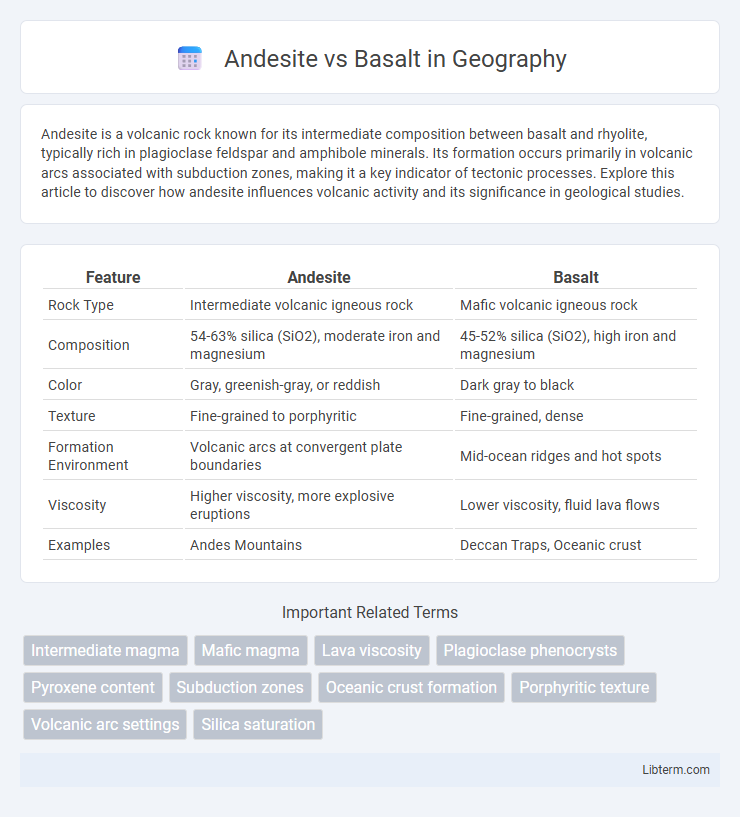Andesite is a volcanic rock known for its intermediate composition between basalt and rhyolite, typically rich in plagioclase feldspar and amphibole minerals. Its formation occurs primarily in volcanic arcs associated with subduction zones, making it a key indicator of tectonic processes. Explore this article to discover how andesite influences volcanic activity and its significance in geological studies.
Table of Comparison
| Feature | Andesite | Basalt |
|---|---|---|
| Rock Type | Intermediate volcanic igneous rock | Mafic volcanic igneous rock |
| Composition | 54-63% silica (SiO2), moderate iron and magnesium | 45-52% silica (SiO2), high iron and magnesium |
| Color | Gray, greenish-gray, or reddish | Dark gray to black |
| Texture | Fine-grained to porphyritic | Fine-grained, dense |
| Formation Environment | Volcanic arcs at convergent plate boundaries | Mid-ocean ridges and hot spots |
| Viscosity | Higher viscosity, more explosive eruptions | Lower viscosity, fluid lava flows |
| Examples | Andes Mountains | Deccan Traps, Oceanic crust |
Introduction to Andesite and Basalt
Andesite and basalt are both extrusive igneous rocks formed from cooled lava. Andesite typically has an intermediate composition rich in plagioclase feldspar and amphibole, resulting in a medium-gray color, while basalt is mafic with higher iron and magnesium content, giving it a dark gray to black appearance. These rocks are common in volcanic regions, with andesite often associated with subduction zones and basalt prevalent in oceanic crust and mantle plume settings.
Geological Origins and Formation Processes
Andesite forms primarily in subduction zone volcanic arcs where oceanic crust melts and mixes with mantle material, resulting in intermediate silica content and diverse mineralogy. Basalt originates from partial melting of the upper mantle at mid-ocean ridges and hotspots, characterized by low silica content and high iron and magnesium levels. The contrasting formation processes influence their texture, mineral composition, and tectonic settings, with andesite reflecting more complex magmatic differentiation compared to the typically homogenous basalt.
Mineral Composition Comparison
Andesite primarily consists of plagioclase feldspar with significant amounts of amphibole, biotite, and pyroxene minerals, reflecting an intermediate silica content between basalt and rhyolite. Basalt is richer in mafic minerals such as pyroxene and olivine, with lower silica content and higher iron and magnesium levels. The distinct mineral compositions influence the physical properties and volcanic behavior of these igneous rocks.
Color and Texture Differences
Andesite typically displays a gray to greenish-gray color with a fine-grained, porphyritic texture characterized by larger crystals embedded in a finer matrix. Basalt appears darker, usually black or dark gray, and has a uniformly fine-grained, dense texture due to rapid cooling of lava at the surface. The color and texture distinctions between andesite and basalt are linked to their mineral composition and cooling history, impacting their volcanic rock classification.
Physical Properties: Hardness and Density
Andesite exhibits a Mohs hardness of approximately 6 to 7, making it slightly harder than basalt, which typically ranges from 5 to 6. The density of andesite averages around 2.5 to 2.8 g/cm3, whereas basalt is denser, with values between 2.8 and 3.0 g/cm3. These differences in hardness and density influence their suitability for construction and industrial applications, with basalt favored for its robustness and andesite valued for its moderate strength and lighter weight.
Major Locations and Global Distribution
Andesite primarily forms in volcanic arcs associated with convergent plate boundaries, prominently found in the Andes Mountains of South America and the Cascade Range in North America. Basalt is the most widespread volcanic rock globally, dominating oceanic crust and large igneous provinces such as the Columbia River Basalt Group in the United States and the Deccan Traps in India. These distinct geographic distributions reflect differences in tectonic settings, with andesite linked to subduction zones and basalt often associated with mid-ocean ridges and hotspots.
Uses in Construction and Industry
Andesite and basalt are both igneous rocks commonly used in construction and industry, with basalt favored for its high density and durability in road base, concrete aggregate, and asphalt pavement. Andesite's intermediate composition makes it suitable for decorative stone, dimension stone, and facing materials, often valued for its aesthetic appearance and moderate strength. Basalt is extensively used in producing rock wool insulation and fiber reinforcement due to its chemical stability, while andesite is less prevalent in industrial applications beyond construction.
Weathering and Durability
Andesite exhibits moderate weathering resistance due to its intermediate silica content, which allows it to maintain durability in various environmental conditions. Basalt, with its low silica and high iron-magnesium content, tends to weather more rapidly, especially in acidic or humid climates, leading to faster surface degradation. The durability differences between andesite and basalt make andesite the preferred choice for construction requiring long-term stability in areas prone to chemical weathering.
Significance in Volcanology
Andesite and basalt are crucial in volcanology due to their differing magma compositions and eruption styles, with andesite typically associated with intermediate volcanic arcs and more explosive eruptions, while basalt commonly forms from low-viscosity magma in shield volcanoes producing effusive lava flows. The silica content in andesite ranges from 57% to 63%, leading to higher viscosity compared to basalt's 45% to 52%, influencing volcanic behavior and hazards. Understanding these differences aids in predicting eruption patterns and assessing volcanic risks in subduction zones versus mid-ocean ridges.
Summary: Key Differences Between Andesite and Basalt
Andesite and basalt differ primarily in their mineral composition and texture, with andesite being intermediate in silica content and typically fine-grained, while basalt is mafic with lower silica and a denser, finer texture. Andesite often forms in volcanic arcs associated with subduction zones, whereas basalt is commonly found in mid-ocean ridges and hotspots. These differences influence their color, eruption style, and geological settings, making andesite generally lighter and more viscous compared to the dark, fluid basalt.
Andesite Infographic

 libterm.com
libterm.com